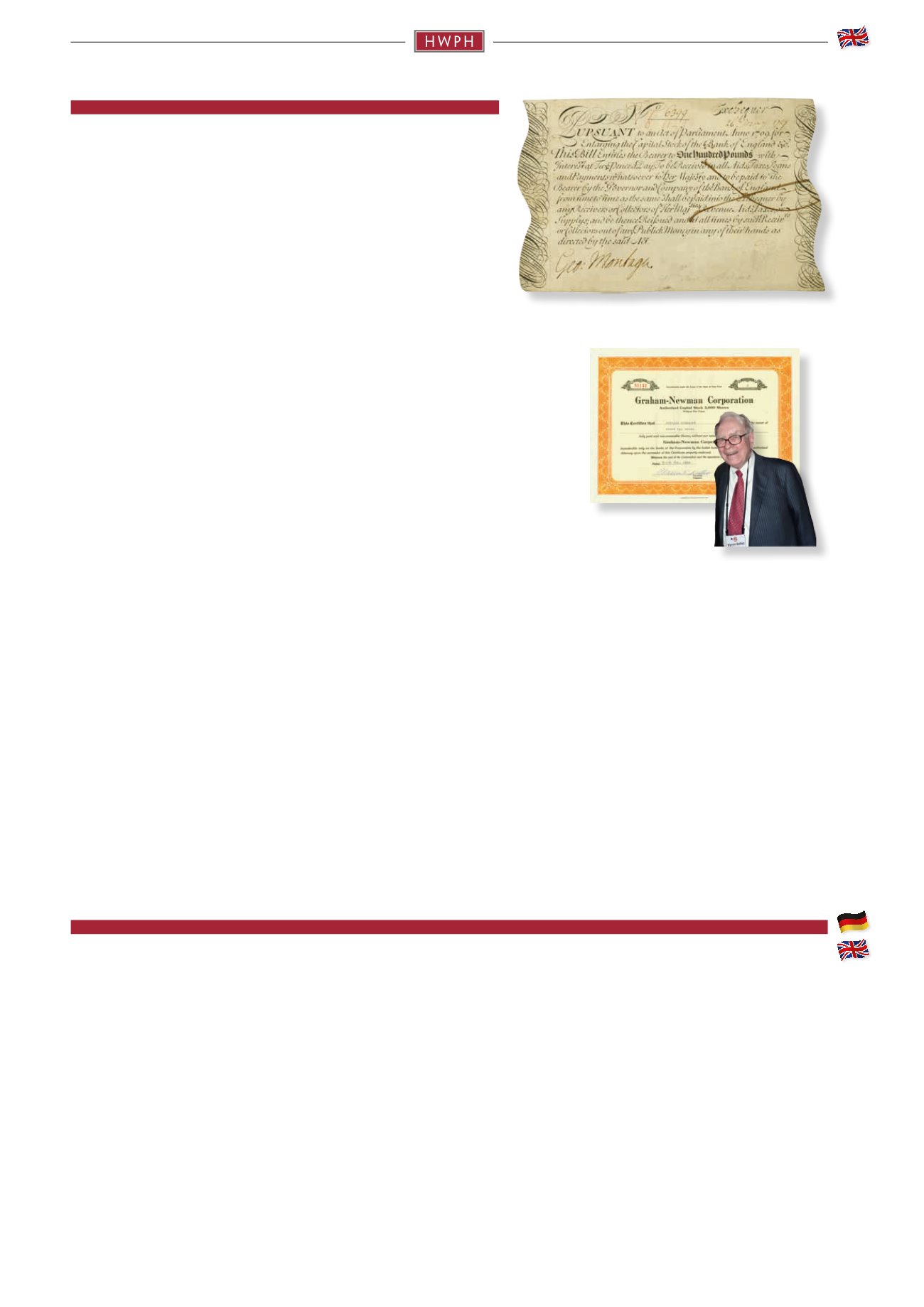

5
Abkürzungen / Abbreviations
Abkürzungen und ihre Bedeutung:
Abb.
= Abbildung = Picture
AG
= Aktiengesellschaft = Joint-stock company
Faks
. = Faksimile-Unterschrift = printed signature
Nr.
= # = Nummer = number
o. D.
= ohne Datum = without date
o. Nr.
= ohne Nummer = without number
RM
= Reichsmark = reichsmark (old German Currency)
OU
= Original-Unterschrift = original signature
KB
= Kuponbogen = all coupons
KR
= Kuponreste = rest of coupons
DB
= Doppelplatt = double sheet of paper
RB
= Reichsbankschatz = Reichsbank Hort
Maße:
Alle Maße sind in cm in der Form Höhe mal Breite angegeben.
All measures mean hight x width (1 cm = 0,3937 inch).
Erhaltungsgrade:
UNC
= uncirculated, neuwertig, vollständig erhalten, ungefaltet,
außer zwischen Mantel und Kuponbogen, Papier sauber (ohne
Flecken), ungelocht usw.
EF
= extremely fine, außerordentlich fein, fast neuwertig, vorzüg-
licher Zustand, sehr leichte Gebrauchsspuren, im Mantel
höchstens einmal gefaltet (dies darf nicht zu streng genommen
werden, denn da die meisten US-Bonds großformatig sind,
wurden sie auf Westentaschenformat gefaltet, dies stellt aber
keine Wertminderung dar).
VF
= very fine, sehr fein, gefaltet, mittlere Gebrauchsspuren,
schwach gefleckt, kleinere Randeinrisse, Klammerlochungen usw.
F
= fine, stärkere Gebrauchsspuren, mehrmals gefaltet, mäßig
starke Flecken, leichte Risse sowie kleinere Fehlstellen in der Falz
möglich usw.
Introduction
We welcome you to our journey through four centuries of financial history.
In this catalogue at hand we present the 50 finest, most interesting, for the
economic development most important and rarest stocks and bonds of our
auction. I invite you to study the stories of the 50 bonds and shares and to look
for parallels with today’s financial world. Especially the story of the Bank of
England is informative. A group of businessmen performed a miracle at the
end of the 17th century: Within a few years people accepted “small pieces of
paper” as means of exchange in the same way as they did with gold and silver.
Annuities were used as security for these banknotes. By this monetisation
of the English government debt money was created for the economy and it
boomed. Nobody really thought of paying back the government debt, because this
would have been meant a reduced money supply to the economy.
And what happens nowadays? Overall in the world central banks weaken the
own currency in order to improve the export chances of local companies. A currency war is
broken out. This will only work, as long as there is trust into the „small pieces of paper“.
This trust can be lost one day, the situation will overturn and we could be very fast in an
environment of hyperinflation. A view to Germany in the 1920th shows us, to what such
inflation leads. Weakening a currency will not stop a stock market crash, which had China
to learn these days. The stock prices fell rapidly and caused heavy losses at other stock mar-
kets all over the world.
When stock markets crash and shareholders get into panic, it is always time of the greatest
investor of all times: Warren Buffett bought his first share at age of eleven years. He was
Secretary Treasurer at Graham-Newman Corporation at age of 25, and worked for Benja-
min Graham, father of the fundamental analysis of stocks. A few days before Buffett foun-
ded his own Buffett Partnership, he signed the offered share certificate. One US-Dollar
invested at that time grew into round about 60 years up to amazing 13,400 US-Dollars.
This shows one more time, what great returns investing in stocks and bonds can offer on
the long run. Buffett also teaches us to „be fearful when others are greedy and greedy when
others are fearful“.
I invite you to start your own journey through four centuries of financial history. Look
out for parallels to today’s situation. The auction of the 50 highlights will take place on 17
October 2015 starting and 3.00 p.m. in Wiesbaden. Use this unique opportunity and write
your own chapter of financial history.
Sincerely yours,
Matthias Schmitt
Warren Buffett worked in the first years of his
investment carrear for Graham-Newmann
Corporation and signed this stock certificate.
Scripophily from the Bank of England, dated 1709.



















